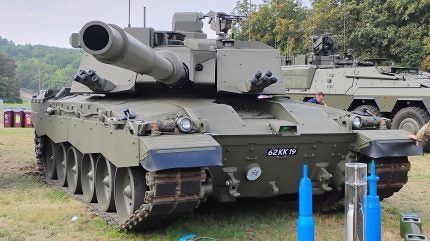
The British Army’s Challenger 3 programme, planned to deliver 148 upgraded Challenger 2 main battle tanks (MBT) into service, has been hit by unspecified delays in the supply chain, the UK government admitted.
As the lead element of the British Army’s future armoured Brigade Combat Teams (BCT), the Challenger 3 is a critical element to the effort to increase lethality in the UK military.
However, a UK parliamentary written response from UK Defence Procurement Minister Maria Eagle stated on 1 April that Challenger 3 had been “impacted” by “some delays” in the supply chain and gave no commitment that the current initial operating capability (IOC) deadline of 2027 would be met.
It is not known at what end of the supply chain is causing the impact to Challenger 3, with systems and subsystems being acquired from a range of European and Israeli suppliers.
“Additional resources have been directed towards resolving these issues and the next phase of trials will start in Quarter 2 2025. Progress will be monitored carefully and any impact on the delivery of initial operating capability will be continually assessed,” Eagle said.
IOC is defined as a single squadron of Challenger 3 MBTs with trained crews.
In addition, the UK govermment also disclosed on 1 April that the Approved Budgetary Level for Challenger 3 remained at £1.9bn ($2.4bn), inclusive of the contract with Rheinmetall BAE Systems Land (RBSL), the joint venture tasked with delivering the MBTs. This figure is a significant increase from the £1.3bn budgeted in 2021.
Should the programme run to its maximum £1.9bn budget, the planned 149 Challenger 3 MBTs would be produced at a cost of £12.8m per vehicle.
While cheaper than buying an equivalent number of Leopard 2A8 MBTs from Rheinmetall, it is also a developmental dead end, with the UK not currently planning on a new tank design post-Challenger 3. It is likely that the UK will seek to join a European programme, such as the MGCS, or any replacement of the US Army’s M1 Abrams.
Challenger 3: the history and the future
Initiated in April 2021 by then Secretary of State for Defence Ben Wallace, the Challenger 3 programme is intended to introduce a fourth generation MBT into the British Army, integrated new technologies into the existing Challenger 2 hull, including a new turret and Rheinmetall’s L55A1 120mm smoothbore main gun.
Additional features include new sensors, the installation of Rafael’s Trophy active protection system, and updated composite armour.
A total of 148 of the British Army’s approximate 200 Challenger 2 MBTs are due to be upgraded, with early prototypes having undergone firing trials in Germany in May 2024.
By the time the programme reaches IOC, currently scheduled to be met in 2027, the average age of the vehicles on which the upgrade will be based will be around 27 years old, with the Challenger 3 MBTs expected to serve until 2040, when the base platforms will be well over 40 years old.
Full operating capability is not expected to be achieved until 2030 at the earliest.




